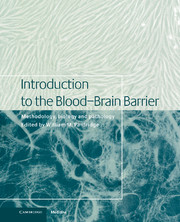Book contents
- Frontmatter
- Contents
- List of contributors
- 1 Blood–brain barrier methodology and biology
- Part I Methodology
- Part II Transport biology
- Part III General aspects of CNS transport
- Part IV Signal transduction/biochemical aspects
- 31 Regulation of brain endothelial cell tight junction permeability
- 32 Chemotherapy and chemosensitization
- 33 Lipid composition of brain microvessels
- 34 Brain microvessel antigens
- 35 Molecular dissection of tight junctions: occludin and ZO-1
- 36 Phosphatidylinositol pathways
- 37 Nitric oxide and endothelin at the blood–brain barrier
- 38 Role of intracellular calcium in regulation of brain endothelial permeability
- 39 Cytokines and the blood-brain barrier
- 40 Blood–brain barrier and monoamines, revisited
- Part V Pathophysiology in disease states
- Index
34 - Brain microvessel antigens
from Part IV - Signal transduction/biochemical aspects
Published online by Cambridge University Press: 10 December 2009
- Frontmatter
- Contents
- List of contributors
- 1 Blood–brain barrier methodology and biology
- Part I Methodology
- Part II Transport biology
- Part III General aspects of CNS transport
- Part IV Signal transduction/biochemical aspects
- 31 Regulation of brain endothelial cell tight junction permeability
- 32 Chemotherapy and chemosensitization
- 33 Lipid composition of brain microvessels
- 34 Brain microvessel antigens
- 35 Molecular dissection of tight junctions: occludin and ZO-1
- 36 Phosphatidylinositol pathways
- 37 Nitric oxide and endothelin at the blood–brain barrier
- 38 Role of intracellular calcium in regulation of brain endothelial permeability
- 39 Cytokines and the blood-brain barrier
- 40 Blood–brain barrier and monoamines, revisited
- Part V Pathophysiology in disease states
- Index
Summary
Introduction
Understanding the structure–function relationship of the BBB depends on the identification of the molecular components involved. One approach to address this topic is based on the generation of monospecific antibodies starting typically from heterogeneous immunogen fractions. The resulting antibodies are then used to identify the corresponding antigens and determine their function, therefore following a structure-to-function strategy. This chapter is focused on antigens of this experimental history, whereas antibodies for characterized vascular endothelial proteins such as glucose transporters, transferrin-and VEGF receptors, junction proteins etc. will be discussed elsewhere. Besides being helpful to reveal the molecular architecture of the BBB, antigens could be employed as diagnostic indexes to evaluate BBB integrity under pathological conditions in vivo or, for example, as differentiation markers in in vitro models.
HT7/Neurothelin
One of the most thoroughly studied antigens present on brain micro vessels is HT7/neurothelin. In two independent approaches using as immunogens either tissue homogenates or purified cell membranes of the embryonic chicken retina, monoclonal antibodies (MAb) HT7 and 1W5 were generated. The corresponding antigens, which have subsequently been shown to be identical, have been termed HT7 (Risau et al., 1986) and neurothelin (Schlosshauer and Herzog, 1990), respectively. As deduced from cDNA sequencing, the antigen has 246 amino acids with a predicted molecular weight of 26 893 daltons.
- Type
- Chapter
- Information
- Introduction to the Blood-Brain BarrierMethodology, Biology and Pathology, pp. 314 - 321Publisher: Cambridge University PressPrint publication year: 1998

